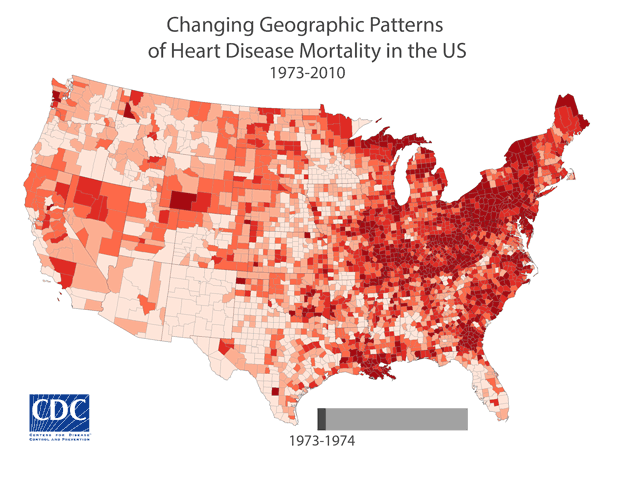Heart disease deaths decline, but some areas hit harder
Deaths from heart disease have declined in the U.S. overall in recent years, but certain areas have seen less progress than others. That's according to new research published today in the American Heart Association's journal Circulation.
Prior research from the AHA found that deaths due to cardiovascular disease declined by almost 29 percent from 2003 to 2013. Still, about 610,000 people die of heart disease in the United States every year, accounting for one in every four deaths, according to the Centers for Disease Control and Prevention.
"Despite the overall decline in heart disease death rates, heart disease remains the leading cause of death in the United States, as well as one of the most widespread and costly health problems facing the nation," Michele Casper, Ph.D., the study's lead author and an epidemiologist at the CDC's Division for Heart Disease and Stroke Prevention, said in a statement.
For the study, the researchers examined death certificates from residents aged 35 years and older in more than 3,000 U.S. counties between 1973 and 2010.
The analysis revealed an important geographic shift in death rates from heart disease over this time.
In the 1970's, the researchers found that the largest concentration of high death rates from heart disease were in counties that stretched from the Northeast through parts of Appalachia and into the Midwest, as well as along coastal areas in North Carolina, South Carolina and Georgia.
But by 2010, those geographic high-rate clusters had shifted much more heavily to the south, below the Mason-Dixon Line.
Counties with the slowest declines in heart disease death rates -- ranging from 9 percent to about 50 percent -- were primarily in Alabama, Mississippi, Louisiana, Arkansas, Oklahoma, and Texas. Conversely, the counties with the fastest declines were located in the northern half of the country, where heart disease deaths dropped by as much as 64 to 83 percent over the four decades.
The study authors say the results show the importance of studying regional differences in heart disease rates for prevention and treatment efforts.
"These findings provide local communities with important historical context regarding their current burden of heart disease, and emphasize the importance of local conditions in heart disease prevention and treatment efforts," Casper said.
While the study did not look at the reasons behind the geographic shifts, the authors say the findings suggest there may have been systematic changes that affected the risk of heart disease deaths in certain populations, including social and economic conditions, dietary habits, public policies, opportunities for physical activity, promotion of smoke-free environments and access to health care.
In an accompanying editorial, Donald A. Barr, M.D., Ph.D., of the Stanford University School of Medicine, noted that it's important for doctors to be aware of these geographic patterns and to try to understand their underlying causes in order to offer the best prevention and treatment regimens to their patients.
"Understanding the associations among these patterns of disease and the social and behavioral factors behind them is essential for the medical profession," he wrote. "As physicians we need to be able to incorporate this understanding into our own practice, while also assuring that future physicians will gain this understanding as part of their medical education."

